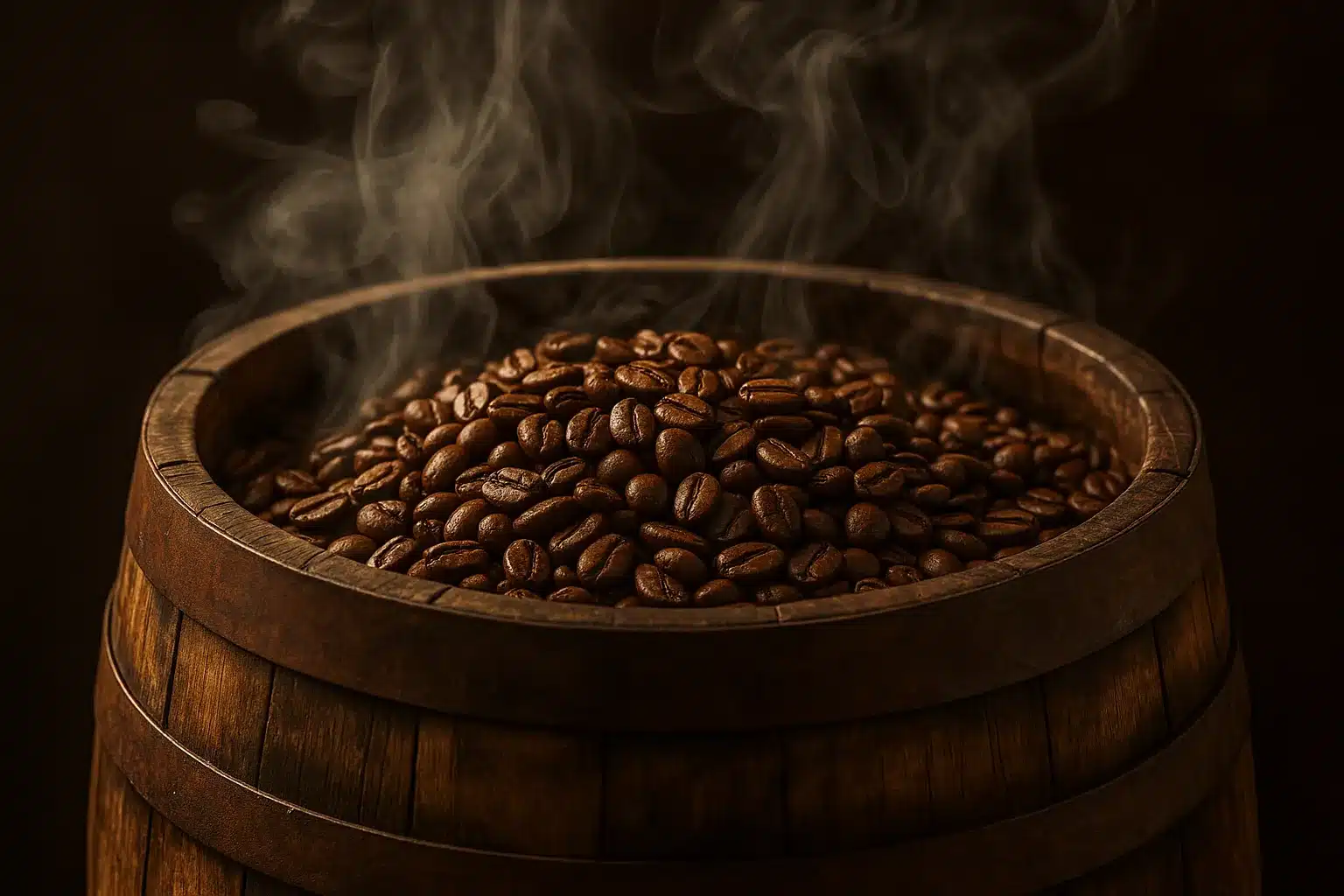
OneHundredCoffee is reader-supported, and some products displayed may earn us an affiliate commission. Details
The first time I tasted a truly aged coffee, I expected something muted and dusty. Instead, the cup felt deep—like dark chocolate had been sculpted into velvet—with a little cedar and spice curling off the rim. Months later, I tried a bourbon-barrel-aged lot and did a double take: caramel, vanilla, a whisper of toasted oak. Same plant, same seed, but two completely different journeys between harvest and roast. That’s the quiet power of storage—how we let time, air, humidity, and wood shape coffee before it ever touches your grinder.
If you’ve ever wondered why “Monsooned Malabar” tastes plush and low-acid, why some Sumatras get rounder with time, or how roasters coax whiskey-kissed notes into a barrel-aged release without adding a drop of liquor, this guide is for you. We’ll walk through the science in plain language, share practical buying and brewing tips, and map what you’ll taste—so you can decide whether aged and barrel-aged coffees belong in your rotation (and how to make them shine when they do).
What “Aging” Means in Coffee (and what it doesn’t)
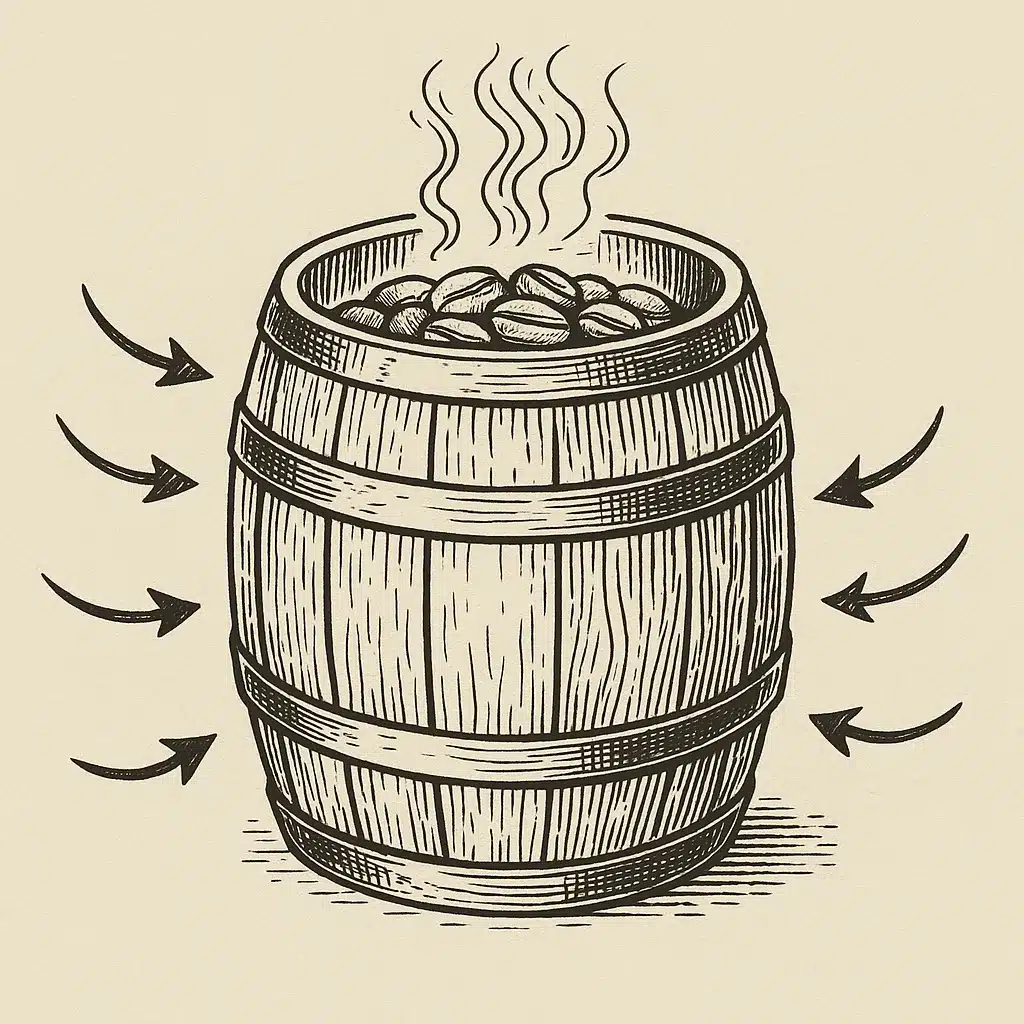
Coffee aging is not about letting roasted beans go stale. It’s about how green beans—the raw, unroasted seeds—are stored and conditioned before roasting. In the right environment, slow, deliberate aging can mellow sharp edges, deepen sweetness, and add distinctive notes (spice, wood, cocoa, pipe tobacco). In the wrong environment, time turns brutal: flavors dull, aromatics die, and your brew tastes flat.
There are three broad ideas to hold:
- Traditional aging: Controlled long-term storage of green coffee to round acidity and develop bass notes (e.g., Aged Sumatra, Monsooned Malabar).
- Barrel aging: Conditioning green coffee inside previously used spirit barrels (bourbon, rye, rum, wine) to pick up aromatic compounds from the wood and residual vapors.
- Everyday storage: The quiet, less flashy—but crucial—management of moisture, oxygen, and temperature that keeps green coffee vibrant until roast day.
Each path has a different flavor promise. The best versions feel intentional, not gimmicky.
The Chemistry (without the lab coat)
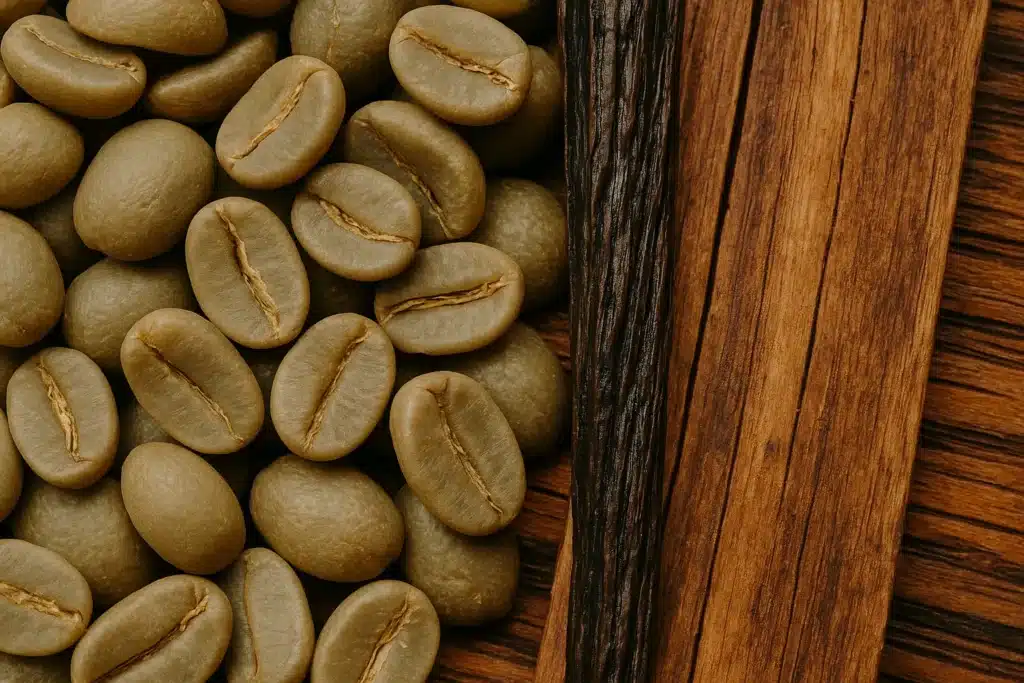
Green coffee is a living pantry of precursors—amino acids, sugars, organic acids, lipids, and bound aromatics—that roasting later transforms into flavor. Storage nudges that pantry.
- Moisture & water activity: Green beans carry ~9–12% moisture. Too dry and flavors thin; too wet and beans risk mold and off-notes. Water activity (how “available” water is) also governs microbial and chemical activity. Good aging lives in the middle.
- Oxidation: Oxygen slowly changes lipids and phenolics. In controlled doses, this can soften acidity and add pleasant wood/spice. Uncontrolled, it flattens fruit and produces cardboard notes.
- Volatile migration: Barrels contain trapped aromatics from the prior spirit—vanillin from oak, lactones (coconut/woody), caramelized congeners, plus spirit vapors. Over weeks, these volatiles migrate into the outer layers of the bean.
- Polymerization & mellowing: With time, certain compounds in traditionally aged coffees shift toward heavier, more unified flavors—less zing, more hum.
Think of storage as a slow marinade for the green seed. You’re not “adding flavoring” to roasted coffee; you’re setting the stage for a different roast and cup.
Traditional Aging Styles (Monsooned, Warehouse-Aged, Aged Sumatra)
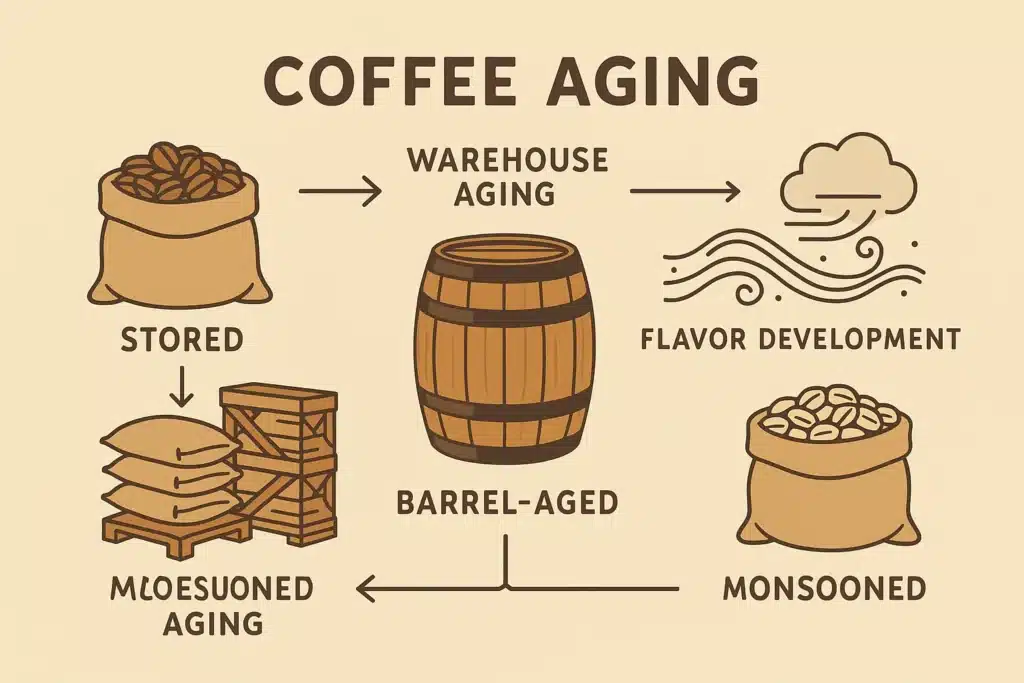
Monsooned Malabar (India)
During the monsoon season, green beans are spread in well-ventilated warehouses to absorb humid sea air, then raked and rested for weeks. The beans swell, turn pale, and lose acidity.
Cup profile: Low acidity, heavy body, sweet grains, cocoa, gentle spice, sometimes a sandalwood/cedar character. It can taste like coffee, wearing a warm sweater—soothing, especially as espresso or moka.
Roast notes: Roasters often push a bit deeper to build syrupy sweetness. Too light and it can read cereal-like; too dark and it goes smoky quickly.
Aged Sumatra / Warehouse-Aged Coffees
Producers hold selected lots in cool, controlled spaces for months (sometimes longer), turning bags periodically to keep aging even. The goal is a rounder, weightier profile without losing original soul.
Cup profile: Earthy-sweet cocoa, pipe-tobacco tones, clove, dried fig; acidity tucks back, body moves forward.
Roast notes: Medium-plus development usually suits; watch for a quick slide from “resonant” to “dull” if heat is heavy early.
Barrel-Aged Coffee: How it’s actually done
- Select the barrel: Recently emptied bourbon, rye, rum, or wine barrels (char level, wood type, and previous fill matter).
- Season & sanitize: Barrels are inspected, sometimes lightly reconditioned. The goal: clean wood, residual aroma, no free liquid.
- Load the green beans: Unroasted coffee goes straight into the barrel.
- Roll & rest: Over 2–8+ weeks (varies widely), barrels are rotated to encourage even contact and aroma uptake. Ambient conditions (cool, dry, steady) are key.
- Unload & rest: Beans are aired briefly, then roasted with a profile that preserves the barrel’s signature without scorching surface aromatics.
No alcohol is added to the beans; you’re tasting barrel aromatics—not a spiked beverage.
What determines the flavor?
- Spirit type: Bourbon (vanilla, caramel, toasted oak), rye (spice: pepper, baking spice), rum (molasses, brown sugar), wine (red fruit, tannin, oak sweetness).
- Barrel life: First-fill vs heavily used changes aroma intensity.
- Time & temperature: Longer isn’t always louder; too long can turn woody and astringent.
- Bean choice: Neutral chocolatey bases (Brazil, Colombia, some Centrals) often carry barrel notes gracefully; delicate florals can get overshadowed.
What you’ll taste (and what you won’t)
Traditional aging
- More bass, less treble: Acidity softens; mouthfeel thickens.
- Wood & spice: Cedar, sandalwood, faint clove or tobacco, cocoa.
- Sweetness shifts: From fruit sweetness toward caramel/treacle.
Barrel aging
- Vanilla & caramel (bourbon): Think crème brûlée edge over milk chocolate.
- Baking spices (rye): Cinnamon, nutmeg hints, and pepper on the finish.
- Molasses & toffee (rum): Brown-sugar richness over nutty bases.
- Red fruit & oak (wine): A plush, jammy accent if well managed.
What you won’t taste (in good examples): harsh alcohol burn, raw wood, solvent. If you do, the barrel or timeline was off, or the roast overcooked delicate surface aromatics.
Roasting considerations (why these coffees can be tricky)
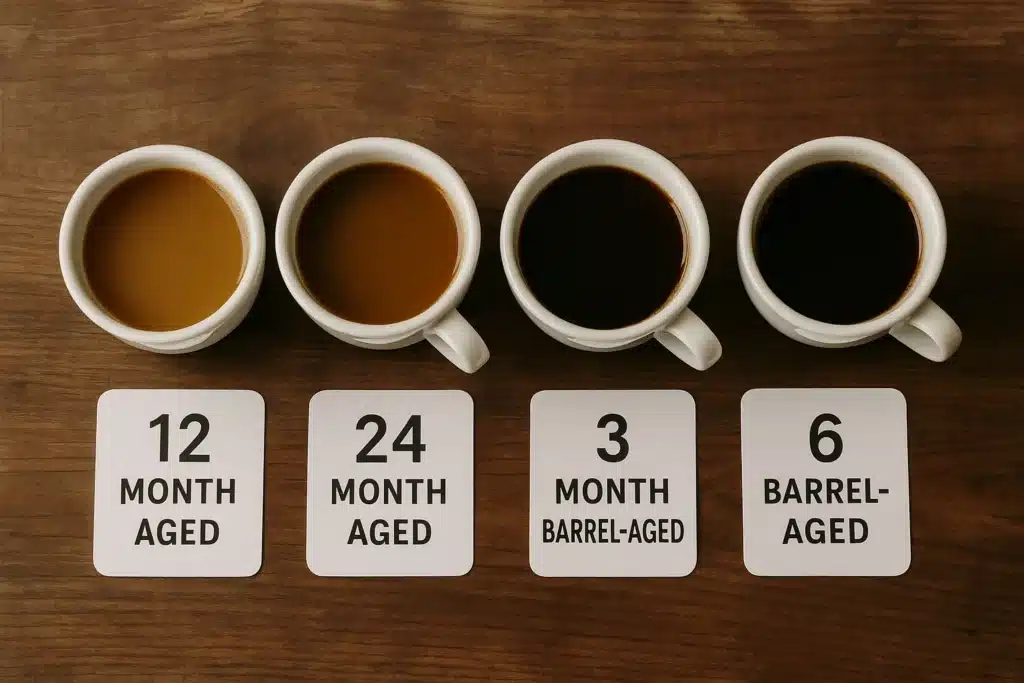
Aged and barrel-aged greens often behave differently in the drum:
- Faster color change: Surface aromatics and altered moisture mean quicker early Maillard reaction.
- Crack timing: First crack can arrive earlier/louder; pay attention to momentum.
- Aroma preservation: Too much early heat can scorch off barrel notes; too little and the cup tastes thin and woody.
Great roasters treat these lots as their own species—smaller charge sizes, gentler heat application early, and development tuned for sweetness without smoke. It’s more conductor than bulldozer.
Brewing: how to let the storage speak
Pour-over (V60, Kalita, Origami)
- Why it works: Paper clarifies the cup, letting you taste vanilla/oak or spice without muddiness.
- Dial-in: Medium grind, 1:15–1:16 ratio. If the barrel note is shy, raise the brew temperature slightly. If it’s loud, drop 1–2°C.
Immersion (French press, cupping)
- Why it works: Builds body to carry wood and cocoa.
- Dial-in: Coarser grind, 4–5 minutes steep, gentle plunge. If it reads heavy, shorten steep or coarsen a click.
AeroPress
- Why it works: Controlled immersion + paper clarity; great for testing.
- Dial-in: 15–18g coffee, 200–220g water, 2-minute brew with a slow press. Play with bypass for sweetness vs intensity.
Espresso
- Why it works: Oak/vanilla pop through milk; aged lots make syrupy shots.
- Dial-in: Start 1:2 ratio in ~28–32s. If shots taste woody/bitter, drop temp; if too thin, grind finer or add 0.5–1g dose.
Water note: A little hardness (calcium/magnesium) helps the body and sweetness. Ultra-soft water can make barrel notes feel ghostly.
Everyday storage for home brewers (post-roast matters too)
Even the best-aged or barrel-aged roast can fade fast if you store it badly.
- Air & light: Keep in a one-way valve bag or airtight canister, away from sun and heat.
- Freeze for freshness: If you won’t finish in 2–3 weeks, portion and freeze airtight. Grind straight from frozen to protect volatiles.
- Don’t “rest” for weeks: Most barrel-aged profiles are best from days 5–21 post-roast; beyond that, the oak/vanilla edges can dissipate.
How storage shifts flavor architecture (a practical map)
- Acidity: Decreases with traditional aging; barrel aging may soften perceived acidity while adding sweetness and aroma.
- Body: Increases; tactile weight becomes a feature.
- Aromatics: Move from fruit/floral toward wood/spice/caramel (traditional) or pick up bourbon/rum/wine barrel signatures (barrel-aged).
- Sweetness: Leans from fruit sugar to caramel/molasses.
This is why aged coffees make cozy espresso and why barrel-aged lots can be magical in milk drinks: you’re stacking caramel/vanilla on top of chocolate.
Who will love these coffees (and who might not)
- You’ll probably love them if you enjoy chocolate-forward blends, lower acidity, espresso with milk, and dessert-like notes (vanilla, toffee, spice).
- You might not love them if your heart lives in high-sparkle washed Ethiopians and crisp Kenyan acidity. That’s okay—different tools, different moods.
Try one when you want a fireside cup rather than a citrus spritz.
How to evaluate a barrel-aged release (before buying)
- Base coffee: Look for a chocolate-leaning origin; delicate florals are easily overwhelmed.
- Barrel detail: “Bourbon barrel” is a start, but char level, distillery style, or time in barrel can hint at intensity.
- Roaster notes: Seek words like vanilla, caramel, oak, brown sugar, cocoa—not “boozy,” “solvent,” or “hot.”
- Release cadence: Small batches with roast dates listed are a good sign of freshness and intent.
Tasting side-by-side: a simple at-home lab
Brew three cups:
- A standard chocolate-forward Latin American coffee.
- A traditionally aged coffee (Monsooned or Aged Sumatra).
- A bourbon-barrel-aged coffee.
Same ratio, grinder, and water. Taste hot, warm, and nearly cool. You’ll feel the axis tilt:
- Cup 1: clearer acidity, straightforward cocoa/nut.
- Cup 2: lower acid, round body, wood/spice.
- Cup 3: sweetness heightened, vanilla/oak riding on chocolate, gentle “dessert” finish.
Write three words per cup. That small ritual trains your palate quickly.
Common pitfalls (and easy fixes)
- “It tastes woody/bitter.” Lower brew temperature by 1–2°C, coarsen grind slightly, or shorten contact time. On espresso, try a tighter ratio (1:1.8–1:2) at a lower temp.
- “The barrel note is overpowering.” Use paper filters and a higher bypass (AeroPress), or blend 50/50 with a neutral Colombian to tame intensity.
- “It’s flat.” Your lot may be over-aged or over-roasted. Try a pour-over at a higher temperature and a finer grind to pull more nuance—or switch to a fresher batch.
- “It tastes boozy.” That’s often a sign of rushed or sloppy barrel work. Switch roasters; good barrel-aged coffee should taste like dessert, not like last night’s cocktail.
Sustainability & ethics: a quick word
Long storage, transport, and barrel sourcing add cost. Seek roasters who credit producers fairly and who treat aging as craft, not novelty. When barrel-aged projects fund better post-harvest infrastructure or pay premiums for carefully selected lots, everyone wins—from farmer to cup.
Best 5 Selections to Explore Aged and Barrel-Aged Profiles
Cooper’s Cask Coffee — Bourbon Barrel Aged
A reference point for the style: vanilla and caramel laced through cocoa. As pour-over, it’s dessert-leaning; as a latte, it tastes like melted toffee.
Oak & Bond Coffee Co. — Bourbon Barrel Aged
Polished and balanced. Expect toasted oak and crème brûlée over a chocolate-nut base. It shines as a drip or in a smooth cappuccino.
Don Pablo — Bourbon-Infused Coffee
Comforting and crowd-friendly. Brown-sugar sweetness, soft vanilla, and a round finish that handles ice exceptionally well.
Whiskey Barrel Coffee — Whiskey Barrel Aged
Leans into whiskey-sweet aromatics without harshness. Think caramel, gentle spice, and a finishing warmth that’s lovely neat or with milk.
Volcanica Coffee — Monsoon Malabar
A classic, traditionally aged profile: silky body, low acidity, cocoa, and sweet grain. A natural companion for moka pots and espresso.
Ideal for adventurous coffee lovers and whiskey aficionados who crave unique, artisanal flavor in every sip.
Great for small-batch roast enthusiasts and lovers of smooth, bourbon-kissed coffee blends.
Perfect for medium-dark roast lovers who want a refined bourbon experience without the booze.
Made for fans of intense, mission-driven brews with a bourbon finish and serious purpose.
Perfect for espresso lovers and low-acidity coffee drinkers who want depth without bitterness.
FAQs (the questions people actually ask)
Is barrel-aged coffee alcoholic?
No. The beans absorb volatile aromatics from the wood and residual vapors, not liquid spirits. Roasting also drives off residual volatiles. You’re tasting vanilla/oak/caramel aromatics, not drinking alcohol.
Does aging always make coffee better?
No. It makes it different. When done well, traditional aging softens acidity and adds depth. When done poorly, it flattens the cup. Quality in, quality out.
How long should coffee be barrel-aged?
There’s no magic number; it depends on barrel freshness, ambient conditions, and bean choice. Many roasters land in the 3–8 week range. Longer isn’t automatically better.
Can I age coffee at home?
You can experiment, but results vary. A clean, small oak cask and a neutral, chocolate-leaning green coffee give the best shot. Keep it cool, rotate the cask, start tasting after two weeks, and roast small test batches. Expect to learn more than you win at first.
What brew method shows barrel notes best?
Paper-filtered pour-overs show the aromatics cleanly; immersion boosts body and sweetness. For milk drinks, espresso makes the vanilla/oak pop.
A barista’s note: blending for balance
One of my favorite tricks: blend 60% barrel-aged coffee with 40% of a bright, clean washed coffeeSuddenlyyl, you get vanilla-spiked cocoa and a beam of citrus or red apple to lift the finish. It’s a house-blend approach that turns dessert into a complete course.
When to reach for aged or barrel-aged coffee
- After-dinner espresso: Barrel-aged shots slide into milk like they were made for it.
- Cozy weekends: Traditional aged coffees pair with pancakes, fireplaces, and long books.
- Gift season: Barrel-aged releases convert skeptical friends—“I didn’t know coffee could taste like this.”
Final sip
Storage is the quiet, often overlooked chapter of coffee’s biography. Done with intention, it can turn a straightforward seed into something layered and evocative: soft-edged, cocoa-rich aged lots that hum like a cello; bourbon-barrel coffees that drizzle vanilla and toasted oak over chocolate. It’s not about masking origin; it’s about letting time and wood write a footnote that changes the way the story ends.
If you’re curious, start simple: a Monsooned Malabar for body and calm, and a bourbon-barrel-aged release for sweetness and showmanship. Brew them side by side, taste them hot and cool, and let your notes guide your next bag. Coffee is a journey; storage is just one more road. On the right day, it leads somewhere delicious.











